Customer retention is a vital topic for any business
Even a small reduction in churn can lead to a substantial increase in lifetime value (online calculators such as this one can help you estimate the impact for your business). At the same time, if you can reduce churn you can afford to spend less time, effort and money on customer acquisition. Studies indicate that the cost of acquiring a new customer can be anywhere between five and 25 times more expensive than retaining an existing one (HBR)
At the FT, we structure our approach to retention around the customer lifecycle. From early life to the moment of renewal, each stage provides an opportunity to reduce churn – and we are constantly testing new interventions to that end. While some of these interventions are specific to news publishers, we believe there are common lessons for all. Indeed, our retention specialists will happily admit that their inspiration often comes from beyond the world of publishing – particularly from telcos and subscriptions businesses more widely (e.g. Netflix and Spotify). In this blog post, we will share examples of our tactics, as well as examples from other sectors. We hope this will help you make connections with your own business.
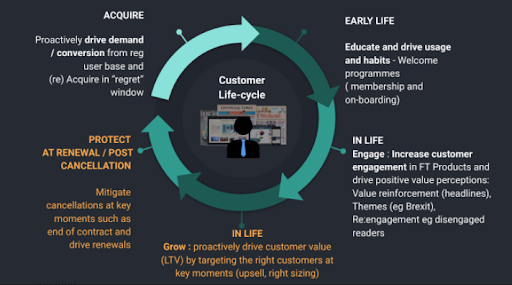




1) Early life
Most subscription businesses see the most dramatic churn early in the customer lifecycle. The numbers are typically stark for publishers. For example, Die Welt has reported that 50% of new subscribers leave in the first three months, after which their churn rate drops to 1-2% monthly (WAN-IFRA). It’s a similar story in the world of subscription e-commerce (e.g. monthly meal kits and personal styling), McKinsey found that more than one-third of consumers who sign up for a subscription service cancel in less than three months, and over half cancel within six (McKinsey).
So what can go wrong in the initial days and weeks following purchase? One typical problem is that your new customers may struggle to understand your product. Another is that customers are not getting the level of value they anticipated. One of the best ways to address both challenges is with a solid customer onboarding strategy. This strategy should be focused on helping people make the most of your product, and build the foundational habits that will retain them as a long term customer.
Slack provides a great example of an intuitive onboarding experience. When you sign up you are introduced to the product in context via overlays within the app. You are also given specific tasks and helpers. For example, Slack provides some pre-written welcome messages that you can send to your first channel. At the same time, Slack keeps things simple by resisting the urge to explain everything at once. Valuable secondary features (e.g. “do not disturb”, voice calls and app integrations) are not introduced in the initial onboarding. Instead, the priority is to get people up and running with basic usage.
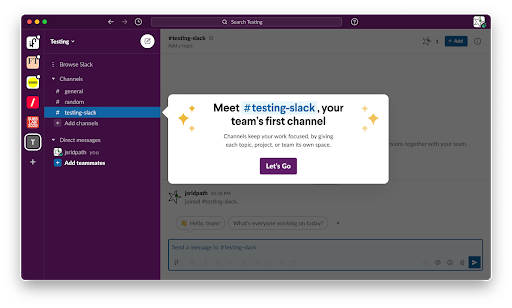




At the FT, we have built our onboarding journeys around the insight that engagement is the most important driver of retention. Low usage following signup leads to some immediate churn, and at the same time, there are huge challenges in recovering engagement after the early days of the customer lifecycle. Our internal research has shown that after the first 90 days engagement is harder to influence. Furthermore, it is far easier to nurture and sustain engagement than to re-engage the disengaged.
To prevent both short and long term churn, the priority of our onboarding is to drive usage and encourage the habits that lead to long term engagement. Our data analysis has shown that the following habits have the greatest impact:
- Signing up to the app & receiving push notifications
- Organically following topics on myFT
- Signing up for newsletters
- Engaging with comments
- Reading on a Saturday or Sunday
- Reading the FT across multiple devices
- Viewing graphics / visual journalism
That is to say, readers that complete the above actions tend to be the most engaged – and are in turn are less likely to churn.
To this end, our onboarding programmes for subscribers and trialists are designed to help users develop these habits – introducing them to specific product features and journalism. To avoid overwhelming new customers, we have a series of onboarding topics that each introduce a new feature each week. For example, in the first week, we introduce the FT’s brand and its unique selling proposition. One week later we educate readers about the FT App, followed by MyFT the following week.
At each stage, we have found that the most effective approach combines education (i.e. guide users through a particular feature) and reinforcement (i.e. acknowledge their usage of that feature). This process is coordinated across email and onsite messaging. For example, a user might first be sent an on-site message alerting them to a new feature (e.g. myFT). If they then use myFT, they are sent an email acknowledging and outlining the product feature, which reinforces their behaviour (e.g. “You’ve saved your first article to myFT”). If they haven’t used the feature after a few days, the user is sent an email to further educate and promote the feature.





2) In life: Sustain
A well-designed onboarding journey may set your customers up for success, but your retention efforts should not stop there. While it is true that any customer can cancel at any time, some customers are more likely to churn than others. To succeed at in-life retention, it is vital to closely monitor your customer base to understand who leaves and who stays (and for what reasons). This insight typically comes from a healthy mix of quantitative data (e.g. app and web analytics) and qualitative studies (e.g. interviews with existing or ex-customers).
At the FT we realised that we could be doing more to specifically help subscribers understand the value that they were getting from their subscription. To this end, we created a “Year in review” campaign, much like Spotify’s yearly campaign which tells a story based on your listening data. In our case, we play back the topics, journalists and stories that individual readers engaged with, as well as sharing insights about their reading patterns.
This campaign proved hugely successful, achieving a 3.3 percentage point uplift in retention rates and saving approximately 50 subscribers per week. For those without the budget or time to invest in this sort of bespoke solution, we have seen other publishers use relatively low tech solutions to achieve similar aims. For example, a letter from the editor re-capping on the year’s most popular stories across all readers might be sufficient to remind subscribers of the value of your journalism.





3) In life: Grow
As well as sustaining in-life customers, we believe that it is important to consider growth as a key part of your retention strategy. By this, we mean that you should proactively drive customer value by targeting the right customers at the right moments with opportunities to upsell and “rightsize”.
At the FT, we are particularly active in the 21 days leading up to renewal. At this point, we segment readers based on their propensity to renew. Based on this information, we provide personalised recommendations around moving to more appropriate tiers. For an engaged user on our standard tier, we might provide an offer for a Premium subscription. Our recent experiments suggest that sampling is key: “try before you buy” offers have been particularly successful in supporting conversion.
While upselling is the obvious preference, it is important to rightsize in both directions. We are experimenting with offering readers with a low propensity to renew – and those not making full use of their higher tier subscriptions – a more appropriate lower-tier product or a price freeze. We have found that the payoff of keeping these customers is well worth any reduction in individual recurring revenue.
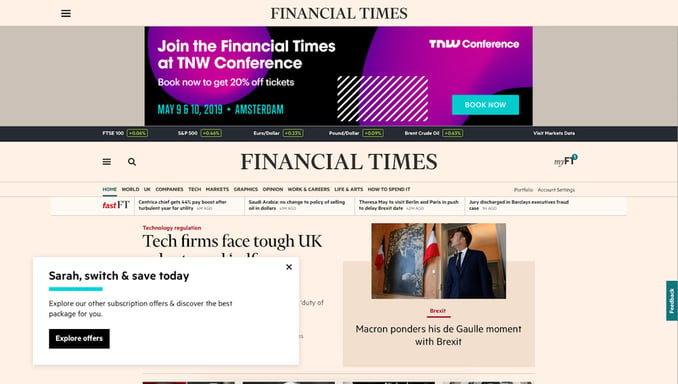




Another way to “grow” within the retention cycle is to offer a referral scheme. For example, mealkit subscription service Hello Fresh offers discounts and free boxes for referrals. While this is primarily a smart acquisition method, referrals also offer a way to increase brand loyalty (and even grow revenue) from existing customers – particularly if you can pick a relevant incentive (e.g. discounts, credits, free products or gift cards).
4) Renewal
Renewal is a crucial moment in the customer lifecycle – particularly for subscription businesses. Customers have a particularly high risk for churn at these moments, even on recurring payment plans. One of the simplest tactics is to reduce the frequency of renewal moment. One popular tactic here is to offer discounts for an annual payment. This has been adopted by many publishers (including the FT) and SaaS subscription businesses (e.g. Zoom, Miro and Slack).
Unfortunately, it is inevitable that some customers will actively decide to cancel their subscription. Previously at the FT, if someone decided to cancel their only option was to contact our call centre. Customers hated this experience, and we developed a hunch that the friction involved was counterproductive, making those that did manage to cancel far less likely to return. In order to address these issues, we developed a new online flow that allowed customers to cancel online. Within the flow, we hoped to persuade customers to change their mind in the process with ‘save’ offers and other features. This new journey doubled our previous save rate (6% of people who started this flow decided not to cancel, compared with 3% previously). We continue to actively experiment with our cancellation flow, and have had success with bespoke prize freezes and “fear of missing out” messaging (e.g. reiterating product features and brand values).
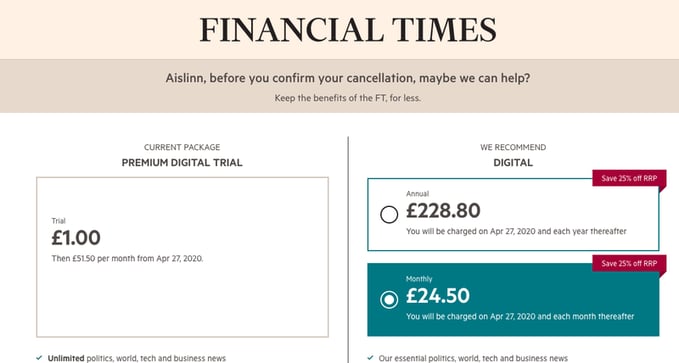









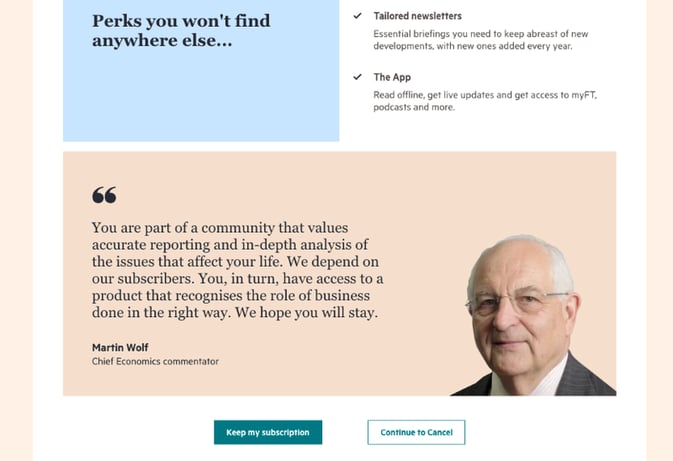




Even if customers don’t actively want to leave, there is a further risk at the point of renewal: Involuntary Churn. This refers to churn occurring passively due to payment failure, a particular risk for businesses that hold credit card details on file. At the FT, we have specialists in Involuntary Churn who are able to develop close relationships with payment companies, and actively test new methods that can mitigate against this challenge (e.g. adjusting timing of payments, automated customer messaging). With this investment, we have been able to increase our involuntary churn recovery rate to 66%.
5) (Re)Acquire
Sometimes, it simply isn’t possible to prevent churn. But there is an opportunity to win these customers back – something we specifically aim to do within the “regret” window. FT experiments in this area have included email campaigns, onsite messaging and call centre interventions. In order to better coordinate and personalise these results, we aim to retain ex-subscribers as registered users (i.e they are still able to login to the FT website, but cannot access paid content).
“Pause my account” is one option used with success by subscription businesses such as Hello Fresh and Amazon Prime. This allows subscription payments and benefits to temporarily end. The benefit here is that you can maintain a customer relationship during this time, and by retaining user data and payment details you are able to reduce the friction involved in a user resuming their paid account. Taking this concept one step further, Audible allows you to place your membership on hold for a three month period – after which service automatically resumes.
How FT Strategies can help
Over the past 18 months, FT Strategies has helped a number of businesses effectively approach the challenge of retention across all stages of the customer lifecycle. We have seen that an important first step is understanding your current performance, particularly relative to industry benchmarks and best-in-class examples. Once you understand where you are, the next step is to define your strategy for mitigating churn and size potential initiatives based on potential impact. At this point, you will be ready to take tangible steps to test new approaches – via customer discovery work and well-designed experiments.
Wherever you are in the journey, retention is one of the shared challenges that led us to create FT Strategies. So we’d be delighted to hear from you if you are rethinking your approach to churn. We have worked with all sizes and shapes of business in various formats – from 2-week design sprints through to longer-term engagements. And as ever, we’re always happy to start with a chat over coffee.
